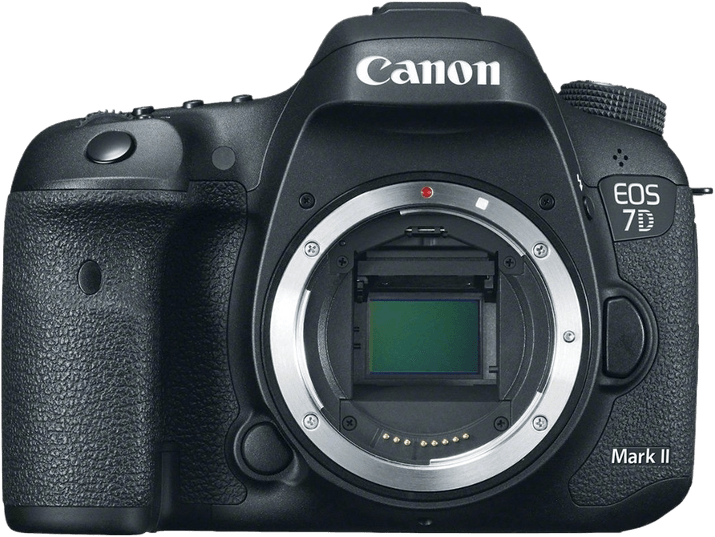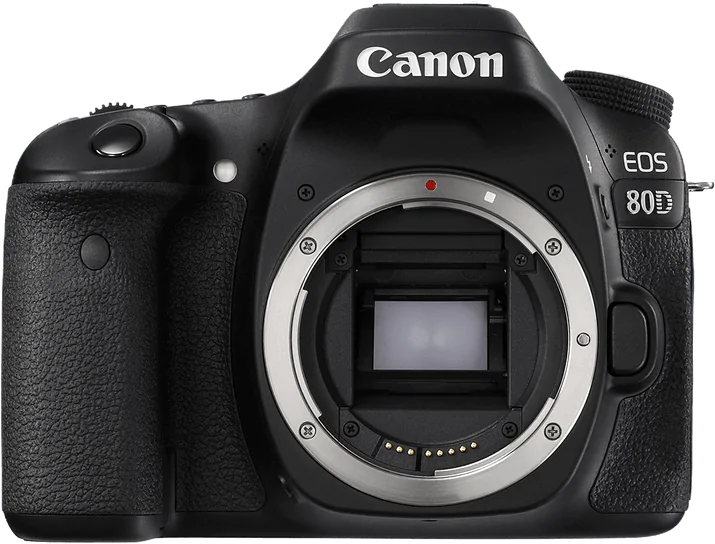Canon EOS 7D Mark II vs EOS 80D Comparison
Canon EOS 7D Mark II

Canon EOS 80D

The Canon EOS 80D comes out ahead with a score of 64/100, compared to the Canon EOS 7D Mark II‘s 60/100. Both cameras are DSLRs, launched in 2014 and 2016 respectively. They share some specifications, such as camera type and similar size, with the EOS 80D measuring 139 x 105 x 79mm and the EOS 7D Mark II at 149 x 112 x 78mm.
The EOS 80D has the advantage of being lighter, weighing only 730g, while the EOS 7D Mark II weighs 910g. Additionally, the EOS 80D has a lower launch price of $1200, compared to the EOS 7D Mark II’s $1800. However, the EOS 7D Mark II may still have its own merits, despite its higher price and weight.
Taking these factors into account, the Canon EOS 80D emerges as the winner in this comparison, offering a better balance of price and weight without compromising on quality.
Canon EOS 7D Mark II vs EOS 80D Overview and Optics
The Canon EOS 80D outperforms the Canon EOS 7D Mark II in optics with a score of 63/100 compared to the 7D Mark II’s 61/100. Both cameras share several specifications, including the CMOS sensor type, APS-C sensor size, Canon EF-S lens mount, and lack of image stabilization.
The 80D’s higher score is due to its superior 24.2-megapixel resolution, compared to the 7D Mark II’s 20.2 megapixels. This difference allows the 80D to capture more detail in images. Additionally, the 80D has a higher DXOMARK score for its sensor, at 79 compared to the 7D Mark II’s 70. This higher score indicates better overall image quality and performance from the 80D’s sensor.
However, the 7D Mark II has some advantages over the 80D. It has a faster shooting speed of 10 frames per second, compared to the 80D’s 7 frames per second. This makes the 7D Mark II better suited for capturing fast-moving subjects or action shots. The 7D Mark II also has a more powerful processor, featuring dual Digic 6 processors while the 80D has a single Digic 6 processor. This results in faster processing and potentially better noise reduction in low-light situations.
Taking these factors into account, the Canon EOS 80D’s higher resolution and better sensor performance make it the better choice for those prioritizing image quality and detail. However, the Canon EOS 7D Mark II’s faster shooting speed and more powerful processor make it a strong contender for action photography and low-light situations.
Canon EOS 7D Mark II vs EOS 80D Video Performance
The Canon EOS 80D outperforms the Canon EOS 7D Mark II in terms of video capabilities, scoring 70/100 compared to the 7D Mark II’s 56/100. Both cameras share some common specifications, such as Full HD video resolution, maximum video dimensions of 1920 x 1080, and a maximum video frame rate of 60fps.
The EOS 80D takes the lead in video performance due to its built-in time-lapse functionality, which the 7D Mark II lacks. This feature allows users to create stunning time-lapse videos without the need for additional equipment or software, making it more convenient and user-friendly for videographers.
On the other hand, the EOS 7D Mark II does not offer any significant advantages over the EOS 80D in terms of video capabilities. Both cameras have the same video resolution, dimensions, and frame rate, leaving the 7D Mark II without a clear edge in this comparison.
In terms of video capabilities, the Canon EOS 80D is the better choice due to its built-in time-lapse feature, which gives it an advantage over the EOS 7D Mark II. The 7D Mark II, however, does not provide any additional benefits in this area. Therefore, for those seeking a camera with superior video performance, the EOS 80D is the more suitable option.
Canon EOS 7D Mark II vs EOS 80D Features and Benefits
The Canon EOS 80D emerges as the winner in the features comparison with a score of 70/100, while the Canon EOS 7D Mark II scores 57/100. Both cameras share some common specifications, such as a 3-inch screen size, 1,040,000-dot screen resolution, Wi-Fi connectivity, and the absence of Bluetooth.
The Canon EOS 80D outperforms the 7D Mark II in two significant aspects: the presence of a touchscreen and a flip screen. The touchscreen allows for quicker and more intuitive control over the camera’s settings, while the flip screen provides flexibility in shooting angles, especially for photography and videography in challenging positions.
On the other hand, the Canon EOS 7D Mark II offers GPS functionality, which the 80D lacks. This feature enables users to geotag their images, making it easier to organize and locate photos based on the shooting location. This advantage may be more appealing to travel and landscape photographers.
In conclusion, the Canon EOS 80D’s higher feature score results from its touchscreen and flip screen capabilities, making it more versatile for various shooting situations. The Canon EOS 7D Mark II’s GPS feature may be valuable for specific users, but it cannot surpass the overall advantages offered by the 80D. Thus, the Canon EOS 80D is the superior choice when considering the features of both cameras.
Canon EOS 7D Mark II vs EOS 80D Storage and Battery
The Canon EOS 7D Mark II outperforms the Canon EOS 80D in storage and battery with a score of 65/100 compared to the 80D’s 43/100. Both cameras share common specifications, such as accepting SD/SDHC/SDXC memory cards, using the LP-E6N battery type, and lacking USB charging capabilities.
The 7D Mark II excels with its dual memory card slots, supporting both SD/SDHC/SDXC and Compact Flash cards. This provides more storage options and flexibility for photographers. However, the 80D has an advantage in battery life, offering 960 shots per charge compared to the 7D Mark II’s 670 shots.
While the Canon EOS 7D Mark II’s superior storage options make it a stronger choice in this category, the Canon EOS 80D’s longer battery life should be considered for those who prioritize shooting time over storage flexibility.
Canon EOS 7D Mark II vs EOS 80D – Our Verdict
Are you still undecided about which camera is right for you? Have a look at these popular comparisons that feature the Canon EOS 7D Mark II or the Canon EOS 80D:

